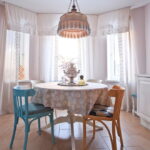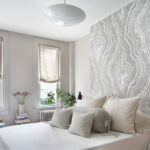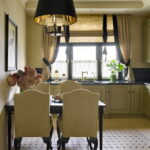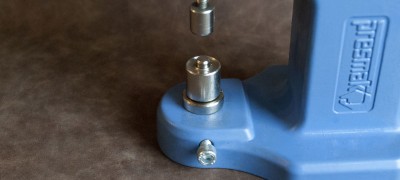Description of linen curtains
Linen curtains are considered one of the best window decoration options. The reason for this is the durability, environmental friendliness and high density of the material. Flax allows air to pass through well, but at the same time retains noise and dust. Due to the fact that linen fabrics are available in different colors and fabrics, they can be matched to any interior and design.

- What are linen curtains
- Advantages and disadvantages of linen curtains
- Types and models of tulle, curtains, curtains
- Color spectrum
- Choosing the size of linen curtains
- Ways of attaching linen curtains
- Ways to decorate linen curtains
- Application in various premises
- Linen curtain care
- Video: linen curtains - environmental friendliness and beauty
- 50 design options for linen curtains in the interior
What are linen curtains
Flax has been very popular for many centuries. Even in Ancient Egypt, they wore clothes made of this material. It was also used for decoration of premises and clothing in Ancient Greece. Flax was undeservedly forgotten in the 20th century. However, now it is returning again thanks to the fact that new fabrics of more noble workmanship and different colors have appeared.

Linen fabric is made from plant material. For the manufacture of fabric, primarily the skin of the stem is used. Although more sophisticated technologies are used in modern production, the basic principle of manufacturing this fabric has not changed for centuries. There are several types of linen fabrics, depending on their manufacture, thickness and smoothness from delicate, thin coarse calico to coarse burlap.
Advantages and disadvantages of linen curtains
Linen curtains have long been used both in Russia and in Europe and more southern countries. Flax has a lot of advantages, because of which it was chosen for window decoration:
- Perfectly breathable. It is not stuffy in such a room.
- Harmonizes the microclimate. In summer, it is not hot in a room with such curtains, and in winter it is not cold. The air here doesn't feel too dry.
- Possesses bactericidal properties. This makes the air in the room cleaner.
- Good noise and dust retention.
- Transmits sunlight. In this case, flax scatters the sun's rays. The room remains bright, but the sun does not interfere with the eyes.
- It is lightweight.
- Convenient in processing and sewing. The seams from it fit easily, the fabric itself is easily obeyed by the seamstress.
- It has anti-static properties. No dust is deposited on this fabric.
- Hypoallergenic. It can be used in rooms where people with allergies or small children live.
- Resistant to wear and tear. Such window decoration will last a long time.
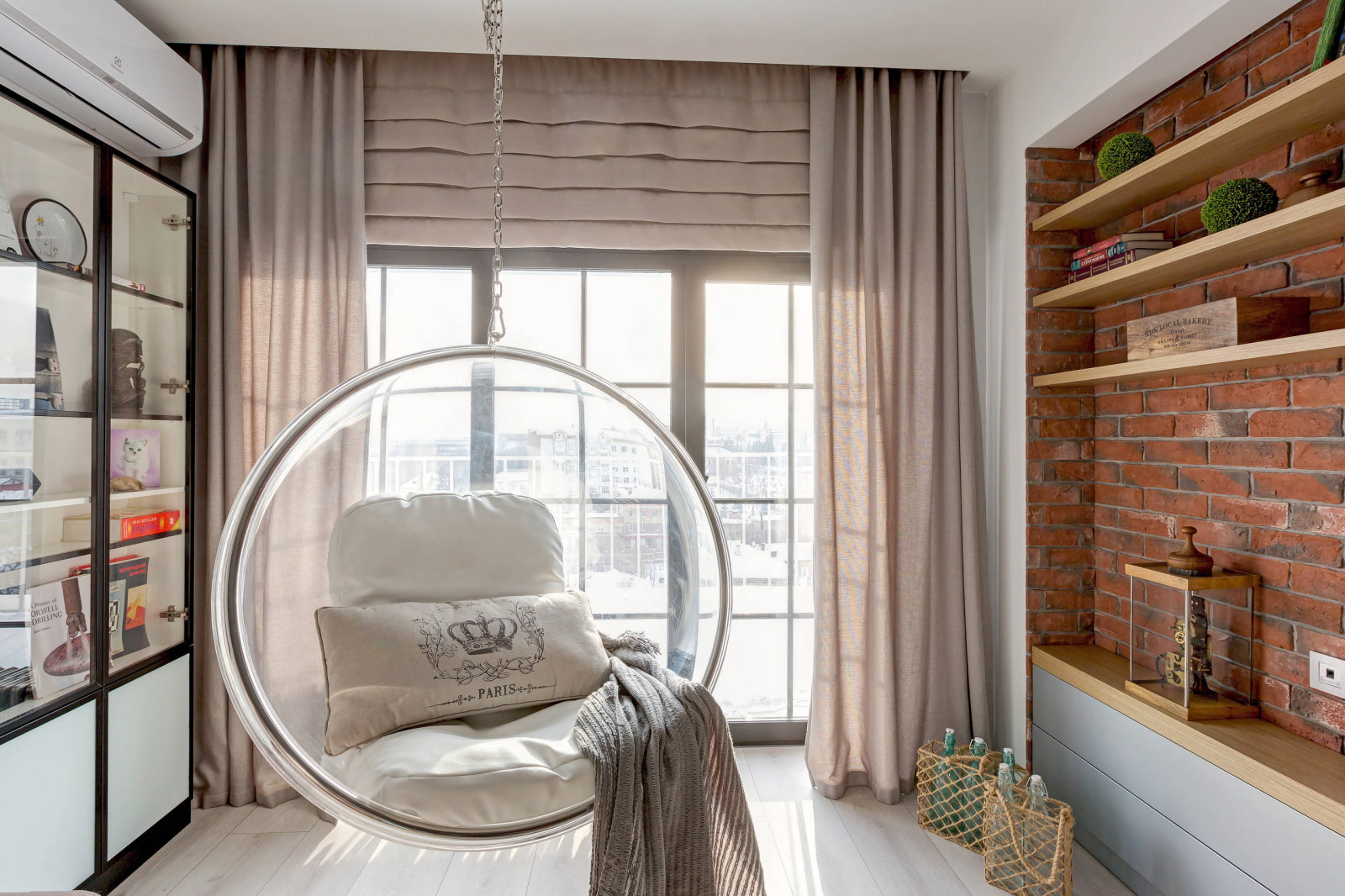
However, like any kind of fabric, this material is not ideal. It also has some minor disadvantages:
- Natural linen is expensive. In Europe, this material is generally considered a great luxury.
- Easy to wrinkle. Creases are often formed on the curtains, they can look sloppy.
- Due to crease, not all types of flax are suitable for making lambrequins or swags.
- Shrinks easily after several washes.
- Does not withstand the effects of bleaches.
Advice. To make the curtains look even and ironed, they should be hung up while still damp.Either after suspension, spray with water or process with a steamer by weight.
Types and models of tulle, curtains, curtains
There is a common misconception that linen is a rough fabric. Only some types of this fabric can be rough. But even in antiquity, fine types of materials were known and widely used. Several types of fabrics are made from linen, which can be used not only for curtains, but also for light tulle or kitchen curtains.
Types of fabrics and curtains
- Batiste. The most delicate linen fabric. It is used to create tulle. The material is very expensive, as it is made from very fine yarn. Another advantage of cambric is the special twist of the thread. Tulle made of it retains dust and noise well. These textiles can be matte or satin. It is often used for a ceremonial, solemn version of curtains. Batiste is painted in different colors, most often in pastel colors. This makes it easy to choose fabric for any interior color scheme.

For this material, it is highly discouraged to use bleaching agents that can destroy it. - Calico. Thin, translucent textiles. The material is widely used for household products. Bed linen and towels are sewn from it. The material is highly practical, easily withstands a large number of washes. Strong enough to withstand good tensile and tensile loads. Compared to other types of linen fabrics, it does not wrinkle much. It scatters sunlight well, retains noise and dust. It is inexpensive. The material is usually matte, painted in different colors. It is very often produced with printed, floral colors. Well suited for Provence style rooms. Textiles are often used for kitchen curtains or for children's rooms.
- Teak. Thick fabric with a beautiful structure. It has several types of weaves, from plain linen to a beautiful, structured hem, similar to twill. It is suitable for heavy curtains. Also, furniture is often covered with this material. The fabric absorbs dust and noise well. The material can have an even color or variegated colors. It fits well into folds and waves. Curtains made from this textile are suitable for any room.

Good for hi-tech, provence, vintage or classic styles. - Canvas. Thick, thick, woven fabric. Has a slightly rough texture. It is often unbleached and unpainted. Certain types of canvases are produced with color. Has increased wear resistance, will last a very long time. Because of this, it is often used for curtains. The curtains come out of it very heavy, but at the same time they cover the room well from the sun, noise and dust. Suitable for hi-tech, loft, vintage or Scandinavian styles.
- Sackcloth. The coarsest linen textiles. The yarn for him practically does not undergo any processing. Because of this, the material looks natural and stylish. Very often it is unpainted and unbleached, has a natural gray-beige color of dry grass. Very cheap. Due to its strength and colorful appearance, it is often used in the interior. Rugs, mats, bedspreads and even tablecloths are made of fabric. It is also used for curtains.

Creates a cozy atmosphere in eco-style rooms, rustic or Scandinavian.
In addition to the types of fabrics, there are also different types of curtains, depending on the finish and appearance.
Curtain linen
For curtains, most often heavy fabrics are used - teak, twill or burlap. At the same time, curtain linen can have a high-quality dressing. So from the outside it will be difficult to assume that the curtains are made of linen. It can also have a stylish plain weave, unbleached, textured threads. Curtain linen is often used in public places because of its strength. In homes, many people use it in the summer because of the air conditioning properties of the room.

Linen curtains Vasilisa
The Vasilisa brand specializes in the production of linen fabrics for curtains and curtains. The curtains are available in different colors, satin and matte. Curtain tulle has high strength, is very transparent and thin. Thanks to this, one cannot immediately say that it was created from flax.
Curtain fabrics are available in both plain and printed colors. At the same time, the colors exist in different themes: from children's to variegated, floral and classic cells.

With lace
Due to the strength and different thickness of fabrics, flax can have a different structure. In addition to classic fabrics, linen with a lace embossed pattern is also produced. It resembles woven lace, although the pattern is actually woven with threads of varying thickness. Linen lace is available in several types. On a transparent cambric base, makes a lace pattern in the same color. This fabric is well suited for a formal tulle in the living room.

Another option for lace fabric is when embossed lace of a different color is made on an opaque base. The base is usually dark brown, purple or burgundy. And the lace pattern can be white, or a lighter shade of the same color. The most colorful will be fabrics that have a different texture of the base and lace. The base is made glossy, and the lace itself is matte. Such textiles look elegant, elegant and gentle at the same time. It is often used for a bedroom or living room.
However, such products have the disadvantage that they quickly accumulate dust due to their texture.
Another option for trimming curtains with lace is the canvas at the bottom of the curtains made of lace linen. This model is well suited for a kitchen or a rustic room.
With hemstitch
To make linen curtains even more colorful, hemstitching or embroidery on the canvas will help. Often it runs along the edge of the piece and creates a bright, stylish canvas. You can buy a trim for finishing in a store or embroider yourself on the canvas. Satin stitch embroidery will look beautiful on curtains. The color of the decor should be in contrast to the color of the material. Then he will look advantageous and stylish.

Openwork hemstitch will look stylish both on curtains and on curtains. It is easiest to do it yourself on a fabric with a plain weave.
Satin stitch or hemstitch embroidery is best suited for country, rustic or Provence style rooms.
Natural fabrics
Linen textiles go well with other fabrics: cotton, velvet, silk, viscose. Most often, a combination of heavy linen curtains and thin cotton or viscose tulle is used.
The combination of different materials and different textures of fabric will look exquisite in complex curtain ensembles. Such options are difficult to buy ready-made, since the fabric will need to be selected individually.

Combination options:
- Double curtains in linen and velvet or thick silk. Matte linen will accentuate the sophisticated texture of other materials. The option can be supplemented with heavy tassels and ties. The model is suitable for a living room with a large window.
- Linen curtains and lambrequin with additional svagas made of thin cotton or silk tulle. Since linen does not lend itself well to drapery, it is better to make beautiful flounces from another material. The combination of these fabrics will make the window appear deeper and more open.
- Cotton or viscose curtains with fine calico tulle. This option is suitable for a bedroom or nursery. Calico will scatter the sun's rays well and create a light atmosphere in the room.The selection of material will make the curtains more budgetary.

Color spectrum
When thinking of linen curtains, many people imagine a gray-beige unbleached material. However, these products can have completely different, unique and colorful colors. They also produce unbleached curtains that are suitable for country style.
Usually, linen products for windows have an even, rich or pastel color: gray, beige, blue, purple, burgundy and even green. Another option is products in pastel colors. They are well suited for a Provence style bedroom or living room. Such products create a gentle, light atmosphere in which it is easy to breathe.

White linen curtains
Usually, curtain fabric is produced in white. White tulle looks very delicate and invisible on the window. Indoors, they create a light, diffused light.
White dense fabric from coarse calico to teak is often used for curtains in the bedroom or in the kitchen. A white linen plain short curtain for the kitchen looks very gentle and stylish, reminiscent of a grandmother's interior. Such white curtains give the impression of sterility and cleanliness. Hemstitch embroidery is well suited to dense white fabric, which will add tenderness and sophistication.

Gray linen curtains
Gray fabrics are often unbleached. This version of curtains is the most practical and environmentally friendly, since the fibers have undergone minimal chemical treatment. Gray, unbleached products will look appropriate in any eco-style or rustic room. They are also suitable for the kitchen or nursery.
However, plain gray fabric in a nursery can look dull. Therefore, it should be decorated with embroidery or applique.

Green linen curtains
Green is rarely chosen for window decoration. This is due to the fact that, as a rule, they are afraid of him and rarely decorate the interior of the room in him. However, the color green is great for relaxing; in a room with a green finish, time flows more slowly. This color helps to restore the psyche and fill energy.
Therefore, it is better to choose green products for a bedroom or kitchen. Here they will create a lively, pleasant atmosphere. For a living room, this color is suitable if other design elements also have green shades.
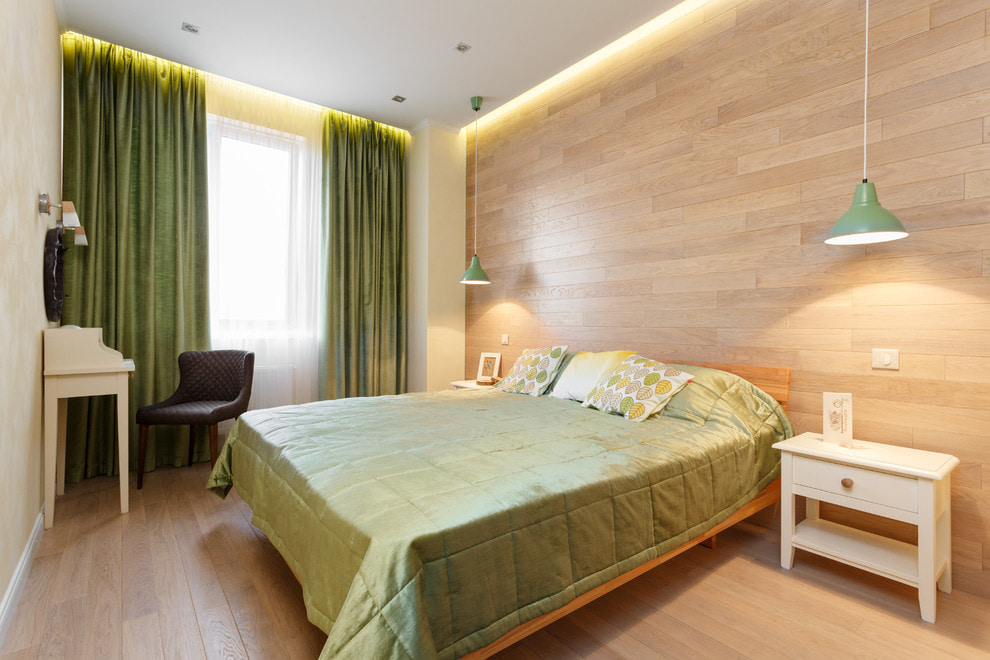
Choosing the size of linen curtains
Due to its different texture, linen curtains are used everywhere. Therefore, the choice of length primarily depends on the purpose of the room and the choice of window decoration design. When choosing the length of linen curtains, several important points should be considered:
- Design design. These are short curtains or long curtains. The length and width of the fabric depends primarily on this.
- Mounting type. Products will be attached to a special tape, hung on loops, hooks or clips. Depending on this, it is worth leaving a small allowance for finishing and hem. The smallest allowance requires fastening to the curtain tape.

Such canvases look elegant and give the window opening a complete look. - Shrinkage of fabric. Flax sits down often. Therefore, it is better to choose a length that is 5-10 cm longer. Moreover, it can be folded from above. If the curtains shrink after several washes, the fabric can be released.
The width of the products depends on how they will be draped. For simple curtains, you need to take the width of the cornice and add 10 cm. This will allow the curtains to hang freely when closed.For complex curtains, you need to take the width one and a half times the width of the cornice. This will allow you to drape the fabric beautifully, even with a fully curtained window.

Ways of attaching linen curtains
It is much easier to hang linen products on the cornice than products from other materials. This is primarily due to the strength of the fabric and ease of processing. There are several options from the simplest with clips to the complex with curtain tape:
- Fastening with clips. Crocodiles with loops are often sold complete with a curtain rod. You can hang a curtain on them by tucking it in. This will take no more than 10 minutes.
- Hinge fastening. To do this, large loops are cut and processed in the fabric. At the same time, the cornice is an ordinary pipe. It is threaded through the loops. Another option for fastening is to sew the loops to the curtains from above. They can be made from the same material or made from threads or ropes. In any case, these loops look very colorful.

With the help of hinges, you can create an unusual design for curtains. - Fastening to the curtain tape. The most difficult option requires certain skills in processing the material. However, if you want to try to sew the curtain tape to the curtain yourself, then linen is the most suitable material for this. This mount is hidden. It is often used to hang a lambrequin.
In addition to attaching linen curtains, there are also suspension methods. Here linen is no different from other fabrics.
- The curtains can be hung in the classic way and move apart in two directions on the sides of the window.
- Another option is Roman shades. They completely close the window and are raised or lowered using a special mechanism. This option resembles blinds, but unlike the latter, it has no slots.
- Roller blinds - also completely cover the window. When lifted, they are rolled into a roll using a special mechanism.

Ways to decorate linen curtains
Thanks to their rich texture, these products have many options for decoration:
- Lambrequin or swagi.
- Embroidery.
- Finishing with lace or sewing.
- Hemstitch embroidery.
- Fringed or tassel trim.
- Creation of applications.
Application in various premises
Linen for window decoration will suit any room. The main thing here is to choose the right color and texture.
In the bedroom
In the bedroom, linen will create a pleasant microclimate. Thanks to such curtains, sleep here will be light and deep, since the air will be clean, moderately humid, and in summer it will not be hot.

Teak, coarse calico or canvas curtains are suitable for the bedroom. Heavy curtains will create silence and protect you from street noise. Curtains with lace will look the most gentle.
On the kitchen
For the kitchen, first of all, a light delicate calico or a denser teak is suitable. You can even decorate the window with a simple plain linen short curtain for the kitchen, which will cost quite inexpensively, but at the same time look very stylish.
In this case, the curtain can be not only sliding, but also rolled or Roman. This option will make it more convenient to use in a small kitchen.

In the living room
For the living room, you should choose the most ceremonial options. These will be curtains made of expensive flax of good workmanship and bright, deep color. They should be supplemented with delicate cambric tulle.
Stylish lambrequin will beautifully decorate the window and create solemnity. Additional ties and brocade tassels will look appropriate.
A country or hi-tech interior can be decorated with less expensive and pompous options from canvas or unpainted teak.

Linen curtain care
Due to its durability, linen is easy to maintain. But at the same time, its processing has several nuances.
It is worth paying attention to the process of ironing the material. If the material is ironed and then folded, then creases will remain. Therefore, these products are usually not ironed. They should be smoothed only after hanging. The easiest and fastest way to do this is with a steamer. If it is not there, you can simply spray the curtains. When dry, they will smooth out on their own.
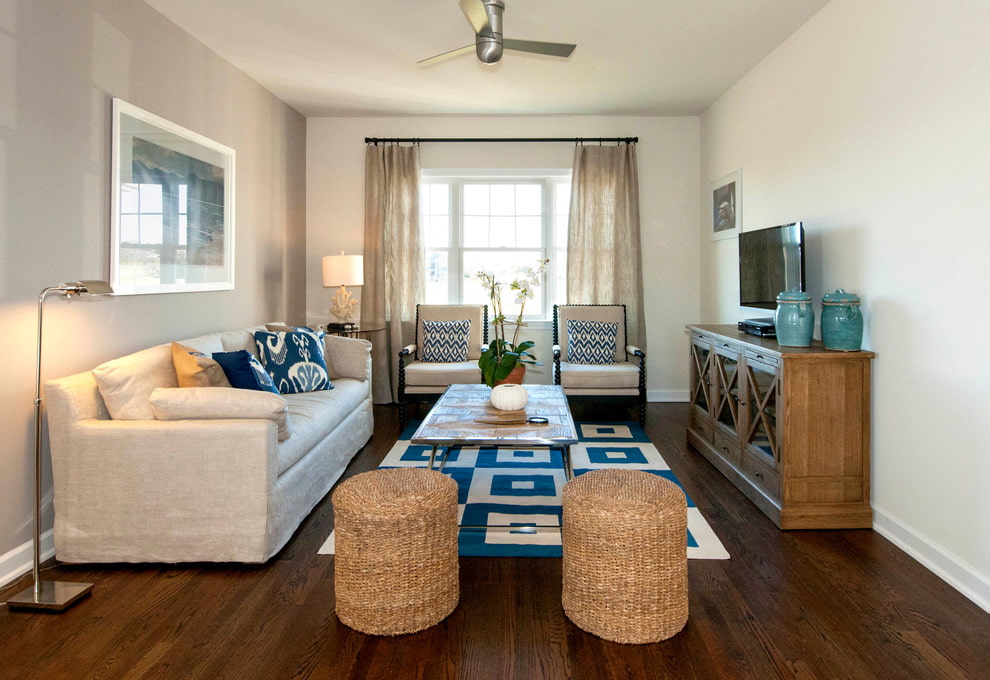
How to wash linen curtains
Washing methods for linen differ depending on the type of fabric. Coarse and dense fabric easily tolerates high-spin machine wash. Coarse calico can also be machine washed, but it is better not to squeeze much.
Thin cambric is best hand washed - it will last longer. Moreover, washing linen is quite easy.
For washing flax, it is better to use less aggressive powders and conditioner. Conditioner will make the fabric softer and easier to iron. However, it is important not to use bleaching or other strong products, as they can significantly damage the fabric.

For dyed flax, it is better to choose a temperature up to 50 degrees. Unpainted, dense fabric can easily withstand hot water at 90 degrees.
Important! Before washing and other processing of the material, you must look at the tag on it, which contains all the important recommendations.
Competent care of the product will allow you to preserve its beauty and color for a long time.
Video: linen curtains - environmental friendliness and beauty




